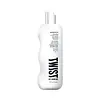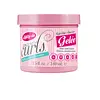What's inside
What's inside
 Key Ingredients
Key Ingredients

No key ingredients
 Benefits
Benefits

 Concerns
Concerns

 Ingredients Side-by-side
Ingredients Side-by-side

Water
Skin ConditioningPolyquaternium-11
Polyquaternium-37
Phenoxyethanol
PreservativeHydroxyethylcellulose
Emulsion StabilisingPPG-3 Benzyl Ether Myristate
EmollientPvp
Emulsion StabilisingIsoceteth-20
EmulsifyingPolyquaternium-7
Hydroxypropyl Bis-Hydroxyethyldimonium Chloride
HumectantGlycerin
HumectantParfum
MaskingArgania Spinosa Kernel Oil
EmollientPanthenol
Skin ConditioningDisodium EDTA
Citric Acid
BufferingIodopropynyl Butylcarbamate
PreservativeHydrolyzed Wheat Protein
Skin ConditioningSericin
Skin ConditioningGuar Hydroxypropyltrimonium Chloride
Skin ConditioningCetrimonium Chloride
AntimicrobialBehentrimonium Chloride
PreservativeBenzyl Salicylate
PerfumingHydroxycitronellal
PerfumingLimonene
PerfumingWater, Polyquaternium-11, Polyquaternium-37, Phenoxyethanol, Hydroxyethylcellulose, PPG-3 Benzyl Ether Myristate, Pvp, Isoceteth-20, Polyquaternium-7, Hydroxypropyl Bis-Hydroxyethyldimonium Chloride, Glycerin, Parfum, Argania Spinosa Kernel Oil, Panthenol, Disodium EDTA, Citric Acid, Iodopropynyl Butylcarbamate, Hydrolyzed Wheat Protein, Sericin, Guar Hydroxypropyltrimonium Chloride, Cetrimonium Chloride, Behentrimonium Chloride, Benzyl Salicylate, Hydroxycitronellal, Limonene
Water
Skin ConditioningPvp
Emulsion StabilisingSorbitol
HumectantCarbomer
Emulsion StabilisingTriethanolamine
BufferingPolysorbate 20
EmulsifyingTetrasodium EDTA
Propylene Glycol
HumectantPanthenol
Skin ConditioningParfum
MaskingAloe Barbadensis Leaf Juice
Skin ConditioningTocopheryl Acetate
AntioxidantHydrolyzed Wheat Protein
Skin ConditioningDiazolidinyl Urea
PreservativeIodopropynyl Butylcarbamate
PreservativeBenzophenone-4
UV AbsorberBenzyl Benzoate
AntimicrobialCI 17200
Cosmetic ColorantIngredients Explained
These ingredients are found in both products.
Ingredients higher up in an ingredient list are typically present in a larger amount.
We don't have a description for Hydrolyzed Wheat Protein yet.
Iodopropynyl Butylcarbamate is a preservative.
Panthenol is a common ingredient that helps hydrate and soothe the skin. It is found naturally in our skin and hair.
There are two forms of panthenol: D and L.
D-panthenol is also known as dexpanthenol. Most cosmetics use dexpanthenol or a mixture of D and L-panthenol.
Panthenol is famous due to its ability to go deeper into the skin's layers. Using this ingredient has numerous pros (and no cons):
Like hyaluronic acid, panthenol is a humectant. Humectants are able to bind and hold large amounts of water to keep skin hydrated.
This ingredient works well for wound healing. It works by increasing tissue in the wound and helps close open wounds.
Once oxidized, panthenol converts to pantothenic acid. Panthothenic acid is found in all living cells.
This ingredient is also referred to as pro-vitamin B5.
Learn more about PanthenolParfum is a catch-all term for an ingredient or more that is used to give a scent to products.
Also called "fragrance", this ingredient can be a blend of hundreds of chemicals or plant oils. This means every product with "fragrance" or "parfum" in the ingredients list is a different mixture.
For instance, Habanolide is a proprietary trade name for a specific aroma chemical. When used as a fragrance ingredient in cosmetics, most aroma chemicals fall under the broad labeling category of “FRAGRANCE” or “PARFUM” according to EU and US regulations.
The term 'parfum' or 'fragrance' is not regulated in many countries. In many cases, it is up to the brand to define this term.
For instance, many brands choose to label themselves as "fragrance-free" because they are not using synthetic fragrances. However, their products may still contain ingredients such as essential oils that are considered a fragrance by INCI standards.
One example is Calendula flower extract. Calendula is an essential oil that still imparts a scent or 'fragrance'.
Depending on the blend, the ingredients in the mixture can cause allergies and sensitivities on the skin. Some ingredients that are known EU allergens include linalool and citronellol.
Parfum can also be used to mask or cover an unpleasant scent.
The bottom line is: not all fragrances/parfum/ingredients are created equally. If you are worried about fragrances, we recommend taking a closer look at an ingredient. And of course, we always recommend speaking with a professional.
Learn more about ParfumPvp is a water-soluble synthetic polymer and common hairstyling ingredient. It is a film-forming ingredient and used to "hold" specific shapes of hair.
Pvp is less effective in high-humidity. It tends to draw moisture, but this moisture dismantles the structure and "hold".
Water. It's the most common cosmetic ingredient of all. You'll usually see it at the top of ingredient lists, meaning that it makes up the largest part of the product.
So why is it so popular? Water most often acts as a solvent - this means that it helps dissolve other ingredients into the formulation.
You'll also recognize water as that liquid we all need to stay alive. If you see this, drink a glass of water. Stay hydrated!
Learn more about Water